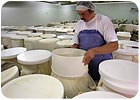
Forte cheese is a mature, press molded cheese based on Parmesan. It was introduced by an Italian firm operating in Estonia in 2001.
In addition, the dairy business was privatized and this caused dramatic change especially for dairy farmers. Many of the big dairy farms were given back to former owners, which meant that farms with up to 2,000 cows had suddenly up to 500 owners. It was obvious that small dairy farms with an average of five cows were not able to survive in the market economy. As a consequence, raw milk production in Estonia dropped dramatically to an all-time low of only 540,000 kg in 1996. Luckily, the market economy brought investors to the dairy business and these individuals started to buy cows and create larger and more competitive dairy farms again.
Today, Estonia has one of the biggest dairy farms in EU, with average farm size of 61 cows and the biggest dairy farms having more than 2,000 cows.
Unfortunately, when Estonia joined the EU in 2004 the country was given only 646,000 tons of milk quota based on the historic dairy production of 1998-2000. The raw milk production had almost reached the Estonian EU quota level of 646,000 tons in 2006. Today, 80% of raw milk comes from large dairy farms with more than 300 cows. Almost all dairy farms are run as private enterprises and sell raw milk either directly or through dairy cooperatives to local dairy producers, as well as to Latvian and Lithuanian dairy companies. Consequently, big investments have been made to build new dairy barns and buy new milking machines with the EU Sapard program. With the help of new technology and improved know-how in cattle feeding, the raw milk quality and yield in Estonia has reached quickly to EU levels and is currently the best among the 10 new member states in the EU. It also means that price of raw milk reached the EU average level during the past three years, and seasonal variation of dairy production has decreased to 10% in 2006.
Estonia’s consumer market of 1.4 million people is too small for local dairy companies. Therefore, 30% of the production is exported to EU, Russia and the world market. For example, Estonia exports to Voru Juust AS, which belongs to the Finnish dairy cooperative Valio Ltd. Voru Juust AS exports more than 70% of its production to Russia, Italy and other EU countries. One of the specialities of Voru Juust AS production represents Forte cheese. Forte cheese is produced according to original Parmesan cheese-making processes. The Forte cheese production started in Estonia in 2001, when an Italian Parmesan producer, Saviola, bought Voru Juust AS. Today, Voru Juust AS, owned by Valio Ltd, produces Forte cheese according to the same principles and under the supervision of an Italian Parmesan cheese master.
The production process of Forte cheese starts with high quality raw milk. For 1 kg of Forte cheese, 13 kg of raw milk is needed. After the special rennet is added to cheese, milk is pressed and whey is separated. Then, the cheese is salted and is matured for 10 months in highly controlled cheese stocks. After the Forte cheese has reached the high quality taste of Parmesan cheese, it is sold as big wheels or repacked in consumer packs to customers in Italy, Baltic countries, Finland and Russia.